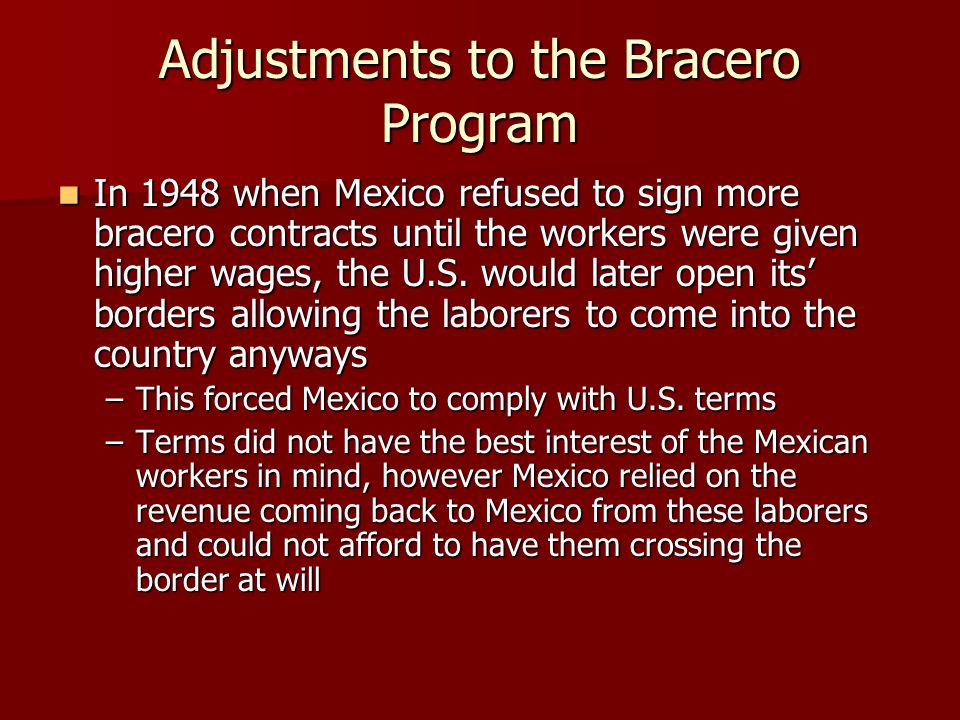What Year Did The Bracero Program End

Bracero Agreement On July 1942 the. 1964-more than nineteen years after the end of World War II. During the Bracero program the short handle hoe.
The Bracero Program 1942-1964 What was the Bracero Program? Parallels with other societal changes? Why did it begin? Why did it end? The Bracero Program 1942-1964. Most railroad braceros did not return to Mexico at the end of their contracts. Bracero Program.
Date: 1942 to 1964 Location: Southwestern states The Event: Cooperative international program through which the United States imported large numbers of Mexican workers—mainly farmworkers—on a temporary basis Date: 1942-1964 Significance: Initiated because of farm labor shortages caused by American entry into World War II, the bracero program brought Mexican workers to replace American workers dislocated by the war. The program was intended to be temporary, but a growing dependence of American farms on Mexican labor kept it going for nearly two decades after the war ended. Bracero workers registering at the Hidalgo, Texas, labor center in 1959. (AP/Wide World Photos) Mexican immigration has historically fluctuated with changing social and economic conditions in both the United States and Mexico. Vista Hotels Channel Islands here. During periods of social unrest, violent uprisings, or bad economic times in Mexico—such as the Mexican Revolution— immigration increased.
When the U.S. Economy has been in decline, Mexican immigration has decreased. Whatever the circumstances, however, Mexico has long been a source of cheap temporary labor for the United States.
Indeed, until the establishment of the U.S. Border Patrol in 1924, the border between the United States and Mexico was virtually unsupervised. Citizens of both countries crossed it as they pleased, and farmers in the American Southwest recruited seasonal workers from Mexico without government interference or supervision.
After the United States entered World War I in 1917, Mexican workers played an important role in keeping American agriculture productive. The bracero program of the 1940’s was essentially a more formal and more tightly supervised international agreement to provide an adequate labor force during and after World War II. However, despite the contributions the program made to American agriculture and to the Mexican economy, it had many vocal critics in both countries.
U.S.-Mexican Relations Relations between the Mexico and the United States have never been intimate. Since the time of the 1846-1848 Mexican War, which ended with Mexico losing half its territory to the United States, relations have been strained. Added to this initial source of conflict was the large-scale 'repatriation” of Mexicans and Mexican Americans during the Great Depression during the early 1930’s, when Mexican workers were indiscriminately rounded up from their workplaces and off the streets on which they lived and summarily sent back to Mexico. Meanwhile, the nationalization by Mexico of its petroleum industry, which resulted in the seizure of property that had been owned by American companies during the 1930’s, caused a festering legal dispute between the United States and Mexico. In addition to these international events involving governments, there was the personal ongoing problem of racist antipathy against Mexicans that was prevalent throughout the American Southwest. A common saying that expressed Mexican feelings toward the United States at that time was 'Poor Mexico, so far from God but so close to the United States.” Mexicans were generally considered 'nonwhites,” forced to live in segregated barrios, and limited to employment in low-level jobs. Nevertheless, the prospect of finding better wages in the United States than those in Mexico has always drawn Mexicans north of the border.